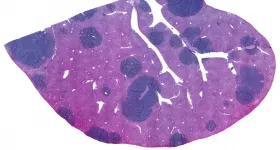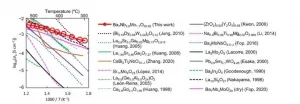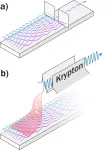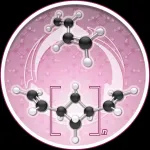The liver processes coconut oil differently than rapeseed oil
The enzymes in fat metabolism have preferences for certain fatty acids, study by the University of Bonn shows
2021-01-25
(Press-News.org) Coconut oil has increasingly found its way into German kitchens in recent years, although its alleged health benefits are controversial. Scientists at the University of Bonn have now been able to show how it is metabolized in the liver. Their findings could also have implications for the treatment of certain diarrheal diseases. The results are published in the journal Molecular Metabolism.
Coconut oil differs from rapeseed or olive oil in the fatty acids it contains. Fatty acids consist of carbon atoms bonded together, usually 18 in number. In coconut oil, however, most of these chains are much shorter and contain only 8 to 12 carbon atoms. In the liver, these medium-chain fatty acids are partly converted into storage fats (triglycerides). Exactly how this happens was largely unknown until now.
The new study now sheds light on this: "There are two enzymes in the liver for storage fat synthesis, DGAT1 and DGAT2," explains Dr. Klaus Wunderling of the LIMES Institute (the acronym stands for "Life & Medical Sciences") at the University of Bonn. "We have now seen in mouse liver cells that DGAT1 processes mainly medium-chain fatty acids and DGAT2 processes long-chain ones."
In their experiments, the researchers blocked DGAT1 with a specific inhibitor. The synthesis of storage fats from medium-chain fatty acids subsequently decreased by 70 percent. In contrast, blocking DGAT2 resulted in reduced processing of long-chain fatty acids. "The enzymes therefore seem to prefer different chain lengths," concludes Prof. Dr. Christoph Thiele of the LIMES Institute, who led the study and is also a member of the Cluster of Excellence Immunosensation.
Surprising side effect
Whether fatty acids in the liver are used at all to build up storage fat depends on the current energy requirement. When the body needs a lot of energy at a particular moment, the so-called beta oxidation is fired up - the fatty acids are "burned" straight away, so to speak. Medically, this metabolic pathway is of great interest. In diabetes, for instance, it might be useful to reduce beta-oxidation. This is because the body then has to meet its energy needs from glucose instead, causing blood glucose levels to drop, with positive implications for the disease.
As early as some 40 years ago, pharmaceutical researchers therefore developed a corresponding inhibitor, etomoxir. It binds to enzymes required for beta-oxidation, bringing it to a halt. However, it quickly became apparent that etomoxir had severe side effects.
The researchers in Bonn have now discovered a possible reason for this: They used etomoxir to inhibit the beta-oxidation of medium-chain fatty acids in mice, in anticipation of using it to boost the production of storage fat. "Instead, fat synthesis also decreased significantly, but only of storage fats with medium-chain fatty acids," Wunderling explains. "We therefore suspect that etomoxir also switches off the DGAT1 enzyme." In the future, he says, it will be necessary to pay attention to such effects when developing new inhibitors of beta-oxidation.
Also interesting is a finding published a few years ago by Austrian and Dutch scientists: They had studied patients suffering from chronic diarrheal diseases. In 20 of them, they found alterations in the DGAT1 gene that rendered it nonfunctional. "We now want to find out whether the impaired processing of medium-chain fatty acids is responsible for the digestive complaints," says Wunderling. This is because the DGAT1 enzyme is active not only in the liver but also in the intestine. Perhaps this is why its disorder causes diarrhea when sufferers consume medium-chain fatty acids. Wunderling: "In this case, they could possibly be helped quite simply - with an appropriate diet."
INFORMATION:
Funding:
The study was funded by the German Research Foundation (DFG) as part of the Excellence Strategy. It additionally received funding from the Austrian Science Fund (FWF) of the Republic of Austria.
Publication: Klaus Wunderling, Christina Leopold, Isabell Jamitzky, Mohamed Yaghmour, Fabian Zink, Dagmar Kratky and Christoph Thiele: Hepatic synthesis of triacylglycerols containing medium-chain fatty acids is dominated by diacylglycerol acyltransferase 1 and ef?ciently inhibited by etomoxir; Molecular Metabolism; https://doi.org/10.1016/j.molmet.2020.101150
Contact:
Dr. Klaus Wunderling
LIMES-Institut der Universität Bonn
Tel. +49-228-7362820
E-mail: klausw@uni-bonn.de
[Attachments] See images for this press release:
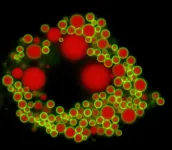
ELSE PRESS RELEASES FROM THIS DATE:
2021-01-25
Research from North Carolina State University shows that extreme weather events, such as hurricanes and increased precipitation, affect both the amount and the composition of picophytoplankton in the Neuse River Estuary. The work is a first step in determining how a wetter climate may affect the estuarine ecosystem.
Picophytoplankton are defined as any phytoplankton measuring less than three micrometers in size. Although well studied as part of the oceanic ecosystem and food web, picophytoplankton are understudied in estuarine systems, even though they occur in significant numbers within these environments.
"Picophytoplankton are important primary producers in aquatic ecosystems," says Ryan Paerl, assistant professor of ...
2021-01-25
DALLAS - Jan. 25, 2021 - Small cell lung cancer (SCLC) cells are missing a surface protein that triggers an immune response, allowing them to hide from one of the body's key cancer defenses, a new study led by UT Southwestern researchers suggests. The findings, reported online today in Cancer Research, a journal of the American Association for Cancer Research, could lead to new treatments for SCLC, which has no effective therapies.
Despite decades of study, SCLC - a subset of lung cancer that makes up about 13 percent of lung cancer diagnoses - has a very poor prognosis, with only about 6 percent of patients surviving five years after ...
2021-01-25
Massive earthquakes are, fortunately, rare events. But that scarcity of information blinds us in some ways to their risks, especially when it comes to determining the risk for a specific location or structure.
"We haven't observed most of the possible events that could cause large damage," explained Kevin Milner, a computer scientist and seismology researcher at the Southern California Earthquake Center (SCEC) at the University of Southern California. "Using Southern California as an example, we haven't had a truly big earthquake since 1857 -- that was the last time the southern San Andreas broke into a massive magnitude ...
2021-01-25
Scientists at Tokyo Institute of Technology (Tokyo Tech), Imperial and High Energy Accelerator Research Organization (KEK) Institute of Materials Structure Science, discover new Ba7Nb4MoO20-based materials with high oxygen-ion (oxide-ion O2-) conductivities--"the hexagonal perovskite-related oxides"--and shed light on the underlying mechanisms responsible for their conductivity. Their findings lead the way to uncovering other similar materials, furthering research on developing low-cost and scalable renewable energy technologies.
Over the past few years, fuel cells have become a focal point of research in eco-friendly technology because of their ...
2021-01-25
Researchers from the Max Born Institute for Nonlinear Optics and Short Pulse Spectroscopy (MBI) have developed a new method to modify the spectral width of extreme-ultraviolet (XUV) light. By employing a novel phase-matching scheme in four-wave mixing, they could compress the spectral width of the initial broadband light by more than hundred times. The detailed experimental and theoretical results have been published in Nature Photonics.
Light, as emitted by the sun, consists of many different colors and typically appears as white. Sometimes, however, only certain colors reach our eyes, leading to stunning phenomena like an afterglow. For technical or scientific applications that require a specific color, gratings and prisms can be used to extract this color ...
2021-01-25
What The Study Did: The results of this study suggest that cumulative exposure to cigarette smoke is an independent risk factor for hospital admission and death from COVID-19.
Authors: Katherine E. Lowe, M.Sc., of the Cleveland Clinic Lerner College of Medicine of Case Western Reserve in Cleveland, is the corresponding author.
To access the embargoed study: Visit our For The Media website at this link https://media.jamanetwork.com/
(doi:10.1001/jamainternmed.2020.8360)
Editor's Note: The article includes conflicts of interest and funding/support disclosures. Please see the article for ...
2021-01-25
What The Study Did: The association of a shelter-in-place order with lower rates of seasonal respiratory viral activity was examined in this study.
Authors: Elizabeth Partridge, M.D., of the University of California at Davis School of Medicine in Sacramento, is the corresponding author.
To access the embargoed study: Visit our For The Media website at this link https://media.jamanetwork.com/
(doi:10.1001/jamanetworkopen.2020.35281)
Editor's Note: The article includes conflict of interest and funding/support disclosures. Please see the article for additional information, including other authors, author contributions and affiliations, conflict of interest and financial disclosures, and funding and support.
INFORMATION:
Media ...
2021-01-25
A study designed to study how the immune system impacts gut bacteria - has led to the extraordinary discovery of two molecules that can not only provide profound protection in experimental models of asthma but can also substantially reduce the severity of an attack.
Neither of these molecules, one of which is already commercially available as a dietary supplement, were previously known to have an effect on asthma - and they also appear, from animal studies, to have a role in treating the respiratory illness that is prevalent, and often fatal, in people with serious COVID-19.
The researchers aim to test one of the molecules in a clinical trial in 2021 in asthmatics.
As further evidence that these two molecules ...
2021-01-25
As the planet's burden of rubber and plastic trash rises unabated, scientists increasingly look to the promise of closed-loop recycling to reduce waste. A team of researchers at Princeton's Department of Chemistry announces the discovery of a new polybutadiene molecule - from a material known for over a century and used to make common products like tires and shoes - that could one day advance this goal through depolymerization.
The Chirik lab reports in Nature Chemistry that during polymerization the molecule, named (1,n'-divinyl)oligocyclobutane, enchains in a repeating sequence of squares, a previously ...
2021-01-25
Human females rely on aids like charting, test strips or wearable tech to identify periods of fertility. Some animals, like baboons, undergo obvious physical changes during ovulation. How did fertility become so hard to detect in humans?
For nearly half a century, the evolution of concealed ovulation in human females has been explained as useful for securing male partners to help raise and support children. A END ...
LAST 30 PRESS RELEASES:
[Press-News.org] The liver processes coconut oil differently than rapeseed oil
The enzymes in fat metabolism have preferences for certain fatty acids, study by the University of Bonn shows

